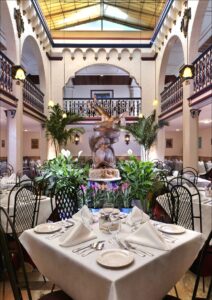Ever evolving, with history at heart
Tampa may not be cool, temperature-wise (Ah, Florida, you and your sunshine. You know I love it.), but it’s one of the most vibrant, fun-filled places I’ve found myself recently. And it keeps growing, with major hotel and entertainment developments popping up through even the past year, and more to come.
Eclectic eats, ample opportunity (perhaps too much) to shop-till-you-drop, blue waters and ocean breeze come to fond memory. And for that extra layer that put Tampa right at the top of my list—and perhaps yours, too—is the city’s dynamic history. Nearly anywhere you go, there’s probably a story behind it, must-visit stops that have stood the test of time and remain an essential part of the city’s here-and-now. So, read on, and take a stroll through Tampa history with me.
Meet and Stay
An ever-growing hotspot for meetings and events, Tampa offers a wealth of options for places to meet and stay. JW Marriott Water Street and Tampa Marriott Water Street are situated across the street from one another, connected via skybridge. Together, they offer just under 131,000 sq. ft. of meeting space and a combination of 1,246 guest rooms.
If you opt to meet at Tampa Convention Center (TCC), just a block away, you’ll first pass one of the historic TECO Streetcar Stations (more on that later) and, once inside, find yourself in a bright, airy and blissfully air-conditioned 600,000 sq. ft. of meeting space. Whether planning a gathering in the 200,000-square-foot exhibition hall or organizing your attendees around the 36 meeting rooms of varying sizes, you can rest assured knowing the convention center is top-rated for sustainability. Energy Star, a federal EPA program, ranks TCC at 84% building efficiency compared with other convention centers at a similar size for its numerous green-building features.
Across the bay, The Current Hotel, Autograph Collection is about as cool as it gets, with an eclectic collection of visual artworks throughout the hotel and a nostalgic grand piano in the lobby. Whether enjoying a meal at the stylish rooftop restaurant Casa Cami or heading to its 5,392 sq. ft. of meeting space and 180 guest rooms, here’s a fun tip: When you get off the elevator, look for the floor number hidden within the abstract painting you’ll be greeted by; the painting changes each time.
What to Eat

If there’s one thing that takes you to Tampa, let dining destination Columbia Restaurant be it. Not only is it Florida’s oldest restaurant, it’s the world’s largest Spanish restaurant. With humble beginnings as a 60-seat cafe, opened in 1905 by the Hernandez/Gonzmart family (and still owned by the same family, five generations later), the Ybor City restaurant now fills the entire block with 12 dining rooms. While I browsed the menu in a feeble attempt to choose just one of the many incredible options for dinner, the tableside sangria was a no-brainer. Yes—you read that right—this restaurant turns crafting the classic drink into a show-stopping performance.
For breakfast and brunch, head to Oxford Exchange, a historic site-turned-dining-experience (it once served as stables at the University of Tampa), where I browsed the joint bookstore and artisan market while awaiting my meal. It’s particularly ideal for attendees such as myself who finished the novel they brought for their trip on the plane ride over. The second floor even offers private meeting and event space that can accommodate up to 200 guests, complete with boardrooms.
Getting Around

A question that remains top-of-mind for every planner seeking to give their attendees the ability to explore their meeting destination: How will everyone get around?
In Tampa, the answer is easy. Hop aboard the historic TECO Streetcar for a free ride to 11 stops between downtown and Ybor City. Operating every 15 minutes, the ride is an experience in and of itself, with classic wood-paneled seats with lantern lighting—the only thing modern about it is that the streetcars are now fully electric.
On a tour of J.C. Newman Cigar Company, the oldest family-owned cigar maker in the United States, I had the opportunity to learn the history of Tampa’s centuries-old cigar industry. Right upon entering, I could browse the museum, which displays a walking timeline of the factory’s founding and business expansion, and comprehensively explains how the cigar industry had such a major impact on Tampa’s economy. Even better, on a guided tour of the factory’s four floors, I saw it in action, as some cigars were still being made with antique, hand-operated machines and others by skilled artisans who make them completely by hand.
This article appears in the September/October 2024 issue. You can subscribe to the magazine here.




